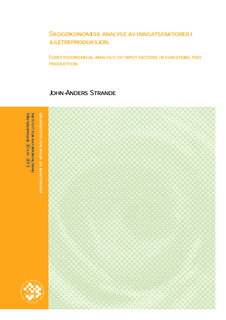Skogøkonomisk analyse av innsatsfaktorer i juletreproduksjon
Master thesis
Permanent lenke
http://hdl.handle.net/11250/187041Utgivelsesdato
2013-08-22Metadata
Vis full innførselSamlinger
- Master's theses (INA) [593]
Sammendrag
Juletrenæringa har selv et mål om å tidoble den norske juletreproduksjonen. Skal dette kunne
oppnås må flere produsenter rekrutteres. Her vil det da bli et stort behov for kunnskap innen
rådgiving og veiledning både i næringa og i offentlig forvaltning.
Jeg vil fremskaffe slik kunnskap ved å finne svar på hvilke innsatsfaktorer som er lønnsomme
og hvordan skogfondsordningen påvirker lønnsomheten av disse. Med utgangspunkt i
juletreproduksjon uten bruk av innsatsfaktorer og størrelsen på avgang, kvalitetsfeil og
juletreutbytte her, har jeg gjort nytte-/kostnadsanalyser av innsatsfaktorene.
Beregningene i oppgaven viser at alle bruk av alle innsatsfaktorer er lønnsomme på premiss
av at det er et problem i produksjonen som kan løses med bruk av innsatsfaktoren. Det er også
grenseverdier for hvor stort omfanget av problemet må være før tiltaket er lønnsomt.
Oppgaven synliggjør også hvor viktig skogfondsordningen er for lønnsomheten av
juletreproduksjon og hvordan den reduseres risikoen ved etablering av en juletreproduksjon.
The Norwegian Christmas tree industry has an objective to tenfold their production. If this is
to be achieved, more producers are to be recruited. There will then be a demand for
knowledge in the industry and the government for advisement.
I will obtain this knowledge by finding which input factors that are profitable and how
“skogfondsordningen” (a Norwegian system for lowering the taxes on income when
investments in establishment of young growth are made in forestry production.) effects the
profitability of these in production of Christmas trees. Starting with a production without the
use of input factors and the quantum of mortality, quality defects and Christmas tree dividend
here, I have made cost/benefit analysis of the input factors.
The calculations in this paper shows that use of all of the input factors are profitable on the
condition that there are a problem in the production that can be solved by applying the input
factor. There are also limits for how big the problem must be before usage is profitable. The
paper also highlights the importance of “skogfondsordningen” for the profitability of a
Christmas tree production and how it reduces the risk of establishing such a production.
